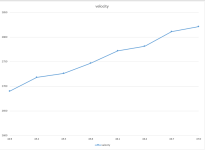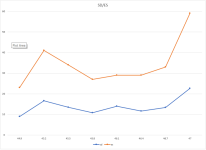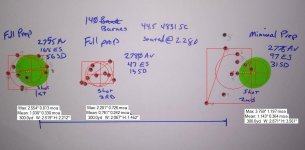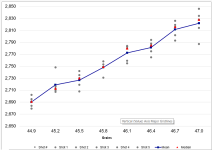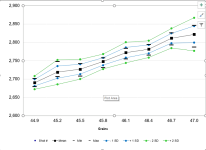CAUTION: The following post (or a page linked to) includes or discusses loading data not covered by currently published sources of tested data for this cartridge (QuickLOAD or Gordon's Reloading Tool data is not professionally tested). USE AT YOUR OWN RISK. Neither the writer, The Firing Line, nor the staff of TFL assumes any liability for any damage or injury resulting from the use of this information.
So I ran some testing today. but I m not sure where to go from here. There was one small flat spot un the curve but It seemed too small to rely on. I had a really good SD on the low end and am considering moving down but am not sure. I feel more testing is needed, however I am not sure if I should tinker around in the 46.1 to 46.4 range the small semi flat spot in the curve. Or work down further from 44.9 since it had the single digit SD in the hopes it might flatten out.
Also the bolt was pretty stiff at 47.0g with no pressure signs on the primers or heads. 46.7 felt ok no pressure signs.
So the loads I am working up are for a 308 using the following.
Hornady 168g OTM loaded to hornady COL 2.800.
BL-c(2) Powder
CCI Large magnum rifle primers
LC brass
outside temp of 55f
5 shots per test group
44.9g, avg 2690, sd 9.04
45.2g, avg 2718, sd 16.66
45.5g, avg 2726, sd 13.44
45.8g, avg 2747, sd 10.18
46.1g, avg 2772, sd 14.02
46.4g, avg 2781, sd 11.46
46.7g, avg 2811, sd 13.41
47.0g, avg 2821, sd 22.61
Average Velocity

SD and ES

So I ran some testing today. but I m not sure where to go from here. There was one small flat spot un the curve but It seemed too small to rely on. I had a really good SD on the low end and am considering moving down but am not sure. I feel more testing is needed, however I am not sure if I should tinker around in the 46.1 to 46.4 range the small semi flat spot in the curve. Or work down further from 44.9 since it had the single digit SD in the hopes it might flatten out.
Also the bolt was pretty stiff at 47.0g with no pressure signs on the primers or heads. 46.7 felt ok no pressure signs.
So the loads I am working up are for a 308 using the following.
Hornady 168g OTM loaded to hornady COL 2.800.
BL-c(2) Powder
CCI Large magnum rifle primers
LC brass
outside temp of 55f
5 shots per test group
44.9g, avg 2690, sd 9.04
45.2g, avg 2718, sd 16.66
45.5g, avg 2726, sd 13.44
45.8g, avg 2747, sd 10.18
46.1g, avg 2772, sd 14.02
46.4g, avg 2781, sd 11.46
46.7g, avg 2811, sd 13.41
47.0g, avg 2821, sd 22.61
Average Velocity
SD and ES
Attachments
Last edited:

